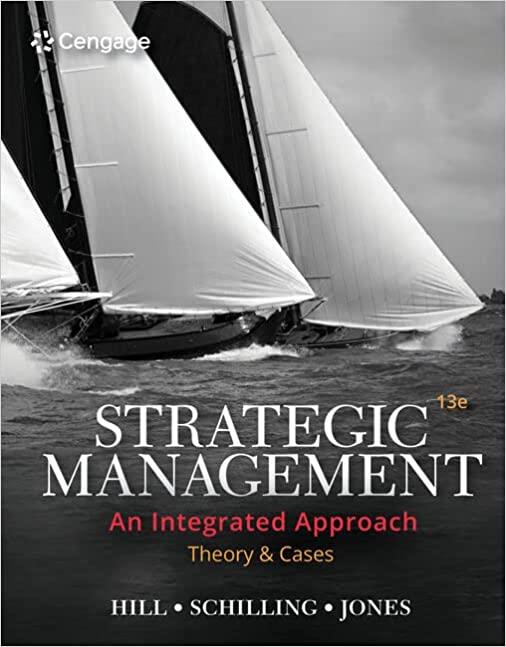Nordstrom is one of Americans most successful fashion retailers. John Nordstrom, a Swedish immigrant, established the company
Question:
Nordstrom is one of American’s most successful fashion retailers. John Nordstrom, a Swedish immigrant, established the company in 1901 with a single shoe store in Seattle. From the very start, Nordstrom’s approach to business was to provide exceptional customer service, selection, quality, and value. This approach remains Nordstrom’s hallmark today.
The modern Nordstrom is a fashion specialty chain with 373 stores in 40 U.S. states, Puerto Rico, and Canada. Nordstrom generated almost $15.5 billion in sales in fiscal 2018 and makes consistently higher-than-average returns on invested capital. Its return on invested capital (ROIC) was 14.6% in 2018–
strong performance for a retailer, and well in excess of its estimated 8% cost of capital (Wal-Mart had an ROIC of 9.17%, and Target an ROIC of 12.5%, in the same period).
Nordstrom, a niche company, focuses on a relatively affluent customer base that is looking for affordable luxury. Its flagship department stores are located in upscale areas and have expensive fittings and fixtures that convey an impression of luxury. The stores invite browsing. Touches such as live music played on a grand piano help create an appealing atmosphere. The merchandise is fashionable and of high quality. What truly differentiates Nordstrom from many of its rivals, however, is its legendary excellence in customer service.
Nordstrom’s salespeople are typically well groomed and dressed, polite, helpful, and known for their attention to detail. They are selected for their ability to interact with customers in a positive way. During the interview process for new employees, one of the most important questions asked of candidates is their definition of good customer service. Thank-you cards, home deliveries, personal appointments, and access to personal shoppers are the norm at Nordstrom. There is a no-questions-asked returns policy, with no receipt required. Nordstrom’s philosophy is that the customer is always right. The company’s salespeople are well compensated, with good benefits and commissions on sales that range from 6.75 to 10% depending on the department. Top salespeople at Nordstrom have the ability to earn over $100,000 a year, mostly in commissions.
The customer service ethos is central to the culture and organization of Nordstrom. The organization chart is depicted as an inverted pyramid, with salespeople on the top and the CEO at the bottom.
According to the president, Blake Nordstrom, this is because “I work for them. My job is to make them as successful as possible.” Management constantly shares anecdotes emphasizing the primacy of customer service at Nordstrom in order to reinforce the culture. One story relates that when a customer in Fairbanks, Alaska, wanted to return two tires (which Nordstrom does not sell), bought some time ago from another store once on the same site, a salesclerk looked up their price and gave him his money back.
Despite its emphasis on quality and luxury, Nordstrom has not neglected operating efficiency.
Sales per square foot are $400 despite the large, openplan nature of the stores, and inventory turns exceed 5 times per year, up from 3.5 times a decade ago—
good figures for a high-end department store. Management constantly seeks ways to improve efficiency and customer service. For example, it was among the first to put mobile checkout devices into the hands of 5,000 salespeople, eliminating the need for customers to wait in a checkout line.
Nordstrom has also segmented the market, offering discounted branded clothing at its Nordstrom Rack stores and associated website. Nordstrom Rack has a younger demographic than the full-line department stores and is an important source of new customers. The stores are much smaller than Nordstrom’s flagship department stores, are typically located in suburban shopping areas, and have a high inventory turnover. However, they share the same customer service philosophy as the flagship stores.
As of 2018, around 230 of Nordstrom’s stores were Nordstrom Rack stores. The Rack stores and website generated about one-fifth of the company’s total revenues, and had higher sales per square foot than the full-line department stores–around $500 compared to $350 at the department stores.
Questions
1. What is Nordstrom’s segmentation strategy?
Who does it serve?
2. With regard to its core department store segment, what does Nordstrom offer its customers?
3. Using the Porter model described in Chapter 5, which generic, business-level strategy is Nordstrom pursuing?
4. What actions taken at the functional level have enabled Nordstrom to successfully implement its strategy?
5. How do the Nordstrom Rack stores fit into the company’s business-level strategy?
6. What is the source of Nordstrom’s long-term, sustainable, competitive advantage? What valuable and rare resources does Nordstrom have that its rivals find difficult to imitate?
7. Is Nordstrom organized for success?
Step by Step Answer:

Strategic Management Theory And Cases An Integrated Approach
ISBN: 9780357033845
13th Edition
Authors: Charles W. L. Hill, Melissa A. Schilling, Gareth R. Jones





